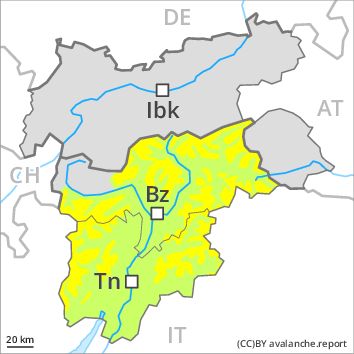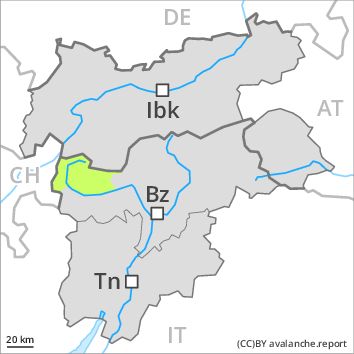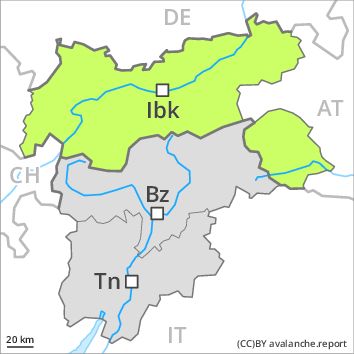Regions
Sexten Dolomites, Latemar, Southern Stubai Alps, Southern Zillertal Alps and High Tauern, Texel Mountains, Southern Adamello, Sarntal Alps, Adamello - Presanella, Western Pfunderer Mountains, Northern Brenta - Peller, Bondone and Stivo, Folgaria - Laverone, Southern Brenta, Southern Lagorai, Northern Lagorai, Maddalene, Pine' - Mocheni Valley, Eastern Pfunderer Mountains, Durreck Range, Western Rieserferner Mountains, Western Deferegger Alps, Ortler Range, Ulten Valley, Eastern Nonsberger Alps, Northern Dolomites of Fiemme, Gröden Dolomites, Primiero - Pale di S. Martino, Prags Dolomites, Prealps, Cembra Valley, Vallarsa, Western Nonsberg Alps, Fassa Valley, Sole, Pejo and Rabbi, Ledro Valley, Paganella, Marzola - Valsugana

Danger level
Danger Level 2 - Moderate above 2200m
Danger Level 1 - Low above 2200m
Avalanche Problem
Wind-drifted snow above 2200m, E-SE-S-SW-W

High altitudes and the high Alpine regions: Fresh wind slabs represent the main danger.
The Avalanche Warning Service currently has only a small amount of information that has been collected in the field. As a consequence of fresh snow and a sometimes moderate northeasterly wind, rather small wind slabs will form in places that are protected from the wind. This applies in particular at high altitudes and in high Alpine regions. Mostly the avalanches are rather small but in some cases easily released.
As a consequence of solar radiation individual moist loose snow avalanches are possible, in particular on steep sunny slopes.
Snowpack
dp 6: cold, loose snow and wind
As a consequence of the strong wind the wind slabs will increase in size additionally. The fresh wind slabs are lying on a crust on east to south to west facing aspects at intermediate and high altitudes. In very isolated cases weak layers exist in the old snowpack. At low altitude no snow is lying.
Tendency
Hardly any decrease in avalanche danger.
Regions
Val Müstair Alps, Langtaufers, Schnals Ridge, Saldurn-Mastaun Ridge

Danger level
Danger Level 1 - Low
Avalanche Problem
Wind-drifted snow above 2200m, E-SE-S-SW-W

High altitudes and the high Alpine regions: Fresh wind slabs require caution.
The Avalanche Warning Service currently has only a small amount of information that has been collected in the field. As a consequence of a strong northerly wind, rather small wind slabs will form in places that are protected from the wind. This applies in particular at high altitudes and in high Alpine regions. Mostly the avalanches are rather small but in some cases easily released.
Low and intermediate altitudes: Areas with glide cracks are to be avoided.
Snowpack
dp 6: cold, loose snow and wind
As a consequence of the strong wind the wind slabs will increase in size additionally. The wind slabs are lying on a crust on east to south to west facing aspects. In very isolated cases weak layers exist in the old snowpack.
At low altitude no snow is lying.
Tendency
As a consequence of solar radiation there will be only a slight increase in the danger of gliding avalanches and moist snow slides.
Regions
Western Verwall Mountains, Eastern Verwall Mountains, Silvretta, Samnaun Mountains, Northern Oetz and Stubai Alps, Western Tuxer Alps, Eastern Tuxer Alps, Western Kitzbühel Alps, Eastern Kitzbühel Alps, Glockturm Range, Weißkugel Range, Gurgler Range, Central Stubai Alps, Northern Zillertal Alps, Allgäu Alps, Venediger Range, Eastern Lechtal Alps - Ammergau Alps, Mieming Mountains, Eastern Rieserferner Mountains, Karwendel Mountains, Glockner Range, Eastern Deferegger Alps, Brandenberg Alps, Wilder Kaiser Mountains - Waidring Alps, Schober Mountains, Lienzer Dolomites, Western Lechtal Alps, Central Lechtal Alps, Grieskogel Mountains

Danger level
Danger Level 1 - Low
Avalanche Problem
Wind-drifted snow above 2200m, N-NE-NW

A generally favourable avalanche situation will prevail. High altitudes and the high Alpine regions: Wind slabs require caution.
The Avalanche Warning Service currently has only a small amount of information that has been collected in the field.
As a consequence of a sometimes moderate northerly wind, rather small wind slabs formed in places that are protected from the wind. This applies in particular at high altitudes and in high Alpine regions. Mostly the avalanches are rather small and can mostly only be released by large loads.
In particular intermediate altitudes: Areas with glide cracks are to be avoided.
Snowpack
dp 6: cold, loose snow and wind
dp 2: gliding snow
As a consequence of the strong wind the wind slabs will increase in size additionally. The wind slabs are lying on a crust on east to south to west facing aspects. In very isolated cases weak layers exist in the old snowpack.
At low altitude no snow is lying.
Tendency
As a consequence of solar radiation there will be only a slight increase in the danger of gliding avalanches and moist snow slides, in particular on very steep sunny slopes.



